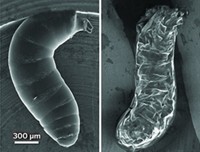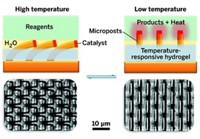Advertisement
Grab your lab coat. Let's get started
Welcome!
Welcome!
Create an account below to get 6 C&EN articles per month, receive newsletters and more - all free.
It seems this is your first time logging in online. Please enter the following information to continue.
As an ACS member you automatically get access to this site. All we need is few more details to create your reading experience.
Not you? Sign in with a different account.
Not you? Sign in with a different account.
ERROR 1
ERROR 1
ERROR 2
ERROR 2
ERROR 2
ERROR 2
ERROR 2
Password and Confirm password must match.
If you have an ACS member number, please enter it here so we can link this account to your membership. (optional)
ERROR 2
ACS values your privacy. By submitting your information, you are gaining access to C&EN and subscribing to our weekly newsletter. We use the information you provide to make your reading experience better, and we will never sell your data to third party members.
Analytical Chemistry
Beetle’s Explosive Spray Mechanism Revealed By X-Ray Imaging
Bioweapon: Pulsed effect driven by chemical reaction
by Jyllian Kemsley
May 1, 2015
| A version of this story appeared in
Volume 93, Issue 18
To fend off predators, bombardier beetles spray a hot, irritating liquid from a gland that behaves like a microscopic chemical reactor. Researchers have now used synchrotron X-ray imaging to reveal details about how the beetles control their built-in weapon (Science 2015, DOI: 10.1126/science/1261166).

The beetles’ pygidial glands have multiple parts, including a reservoir chamber, a reaction chamber, and an exit channel. The reservoir chamber contains an aqueous solution of 25% hydrogen peroxide, 10% p-hydroquinones, and 10% alkanes. The reaction chamber contains peroxidase and catalase enzymes.
When a beetle goes into defensive mode, it transfers the reservoir fluid into its reaction chamber, where enzymatic reactions produce p-benzoquinones—the irritating component of its spray—along with oxygen and heat. Water vaporizes, pressure builds up, and the spray explodes from the exit channel. For one particular group of bombardier beetles, spray explosions come out at about 100 °C, with a velocity of 10 meters per second and a range of several centimeters. They also pulse as quickly as 700 Hz.
But how the beetles control their complex machinery has been a mystery. The new work “is the first internal experimental analysis of the intricate mechanism used by the beetle,” says Andrew McIntosh, a thermodynamics professor at England’s University of Leeds. McIntosh has studied bombardier beetles but was not involved in the current work. He notes that the study confirms earlier research that suggested valves play a role in the beetle spray explosions.
The experiments were carried out by Massachusetts Institute of Technology graduate student Emily M. Arndt and professor of materials science and engineering Christine Ortiz, University of Arizona entomology professor Wendy Moore, and Brookhaven National Laboratory scientist Wah-Keat Lee.
The method they developed was to anesthetize a beetle by cooling it down, then use modeling clay to hold it on a mount. “When the beetle warms up, it realizes that it’s fixed in place, so it gets scared” and releases its explosive spray, Ortiz says. The researchers were able to obtain X-ray images of the spray explosions at 30 to 2,000 frames per second.
Muscles within the reservoir chamber contract to push fluid into the reaction chamber. But only a little fluid goes in at a time, in the form of 5-nL droplets, the team found. As soon as fluid enters the reaction chamber, the enzymes within immediately go to work, and the rising pressure serves both to close a valve between the reservoir and reaction chambers and to blast the spray out the exit. Then the reduced pressure allows the valve to reopen for another cycle. “It’s a very efficient way of controlling the pulse explosion,” Ortiz says.
UPDATE:
This article was updated on July 7, 2022, to reflect Emily M. Arndt's name change.





Join the conversation
Contact the reporter
Submit a Letter to the Editor for publication
Engage with us on Twitter